Perdue Farms Bundle
How Did Perdue Chicken Become a Household Name?
From a small family farm to a poultry industry giant, the Perdue Farms SWOT Analysis reveals a fascinating journey. This brief history of Perdue Farms explores the company's evolution, starting with its humble beginnings in 1920 by Arthur W. Perdue, and its transformation into a leading force in the food and agriculture sector. Discover the key moments and strategic shifts that shaped the legacy of Perdue Chicken.
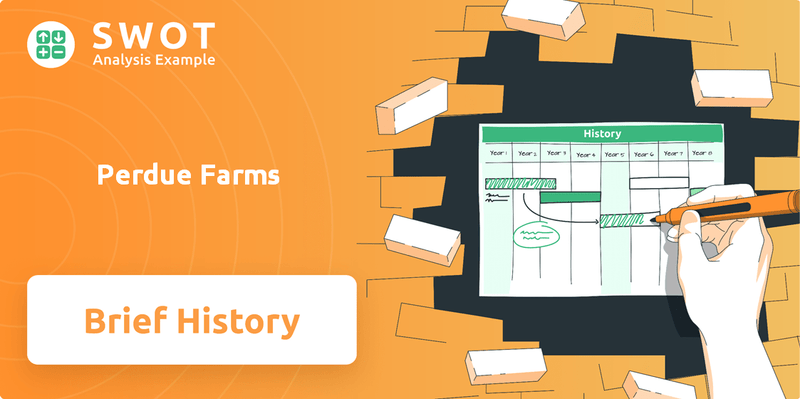
The story of Perdue Farms, including the influence of Frank Perdue, is a testament to innovation and adaptation within the poultry industry. Understanding the Perdue Farms company timeline provides valuable insights into the company's growth and expansion, highlighting how it navigated challenges and capitalized on opportunities in chicken production. Explore the key milestones that transformed Perdue Farms from a backyard egg business into a vertically integrated powerhouse, shaping its market share and sustainability practices.
What is the Perdue Farms Founding Story?
The story of Perdue Farms begins in 1920, a time when the poultry industry was taking its first steps. Arthur W. Perdue and his wife, Pearl Perdue, laid the foundation for what would become a major player in the chicken production market. Their humble beginnings in Salisbury, Maryland, marked the start of a journey that would transform the way America thought about chicken.
Arthur Perdue, with a keen eye for opportunity, transitioned from his role as a railroad agent to the poultry business. He started with a small flock of laying hens, initially selling table eggs. His approach was marked by frugality and a conservative financial strategy, a characteristic that would shape the company's early years. This cautious approach meant slow but steady growth for the first two decades.
Frank Perdue, Arthur's son, joined the company in 1939 at the age of 19, becoming the third full-time employee. This period saw the company adapt to challenges, including a poultry disease that impacted their egg-laying flocks. This prompted a strategic shift to growing broilers for resale, particularly with the rising meat market influenced by World War II. Frank also began experimenting with mixing his own feed to improve quality.
Here's a look at some key moments in the early history of Perdue Farms, highlighting its evolution and the strategic decisions that shaped its future.
- 1920: Arthur W. Perdue and Pearl Perdue establish Perdue Farms in Salisbury, Maryland, starting with laying hens.
- 1925: The company shifts its focus to selling baby chicks to other farmers, building its first hatchery.
- 1939: Frank Perdue, son of Arthur, joins the company, becoming the third full-time employee.
- World War II Era: The company adapts to the rising meat market by growing broilers for resale to processors. Frank Perdue begins experimenting with feed quality.
Perdue Farms SWOT Analysis
- Complete SWOT Breakdown
- Fully Customizable
- Editable in Excel & Word
- Professional Formatting
- Investor-Ready Format
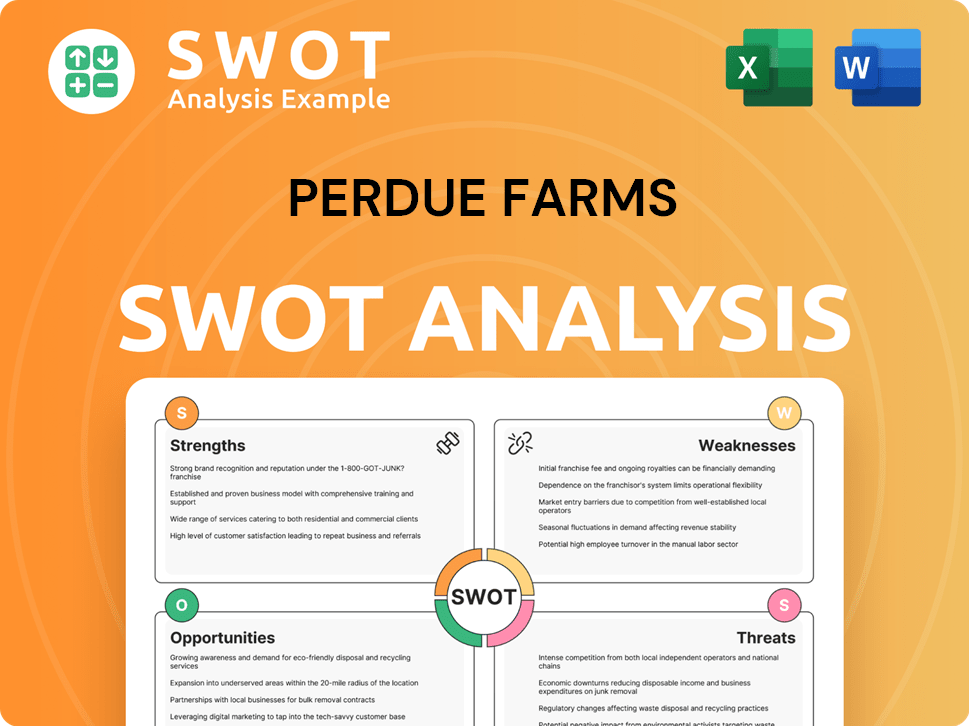
What Drove the Early Growth of Perdue Farms?
The early growth and expansion of Perdue Farms, a pivotal period in the Perdue Farms history, saw the company transition from egg production to broiler chicken sales. This shift, coupled with strategic vertical integration, laid the groundwork for its future success. Under Frank Perdue's leadership, the company transformed, setting the stage for its prominence in the poultry industry.
In the 1940s, Perdue company moved from egg production to raising broilers for processors like Swift & Company and Armour. By 1952, when Frank Perdue took over, annual sales reached $6 million from 2.6 million birds. This early success highlighted the potential for growth within the chicken production market.
The company was incorporated as A.W. Perdue & Son in 1953. A key step in vertical integration was building its first feed mill in 1958, supplying farmers with specialized feed. This was followed by hatcheries, feed mills, and storage facilities, giving Perdue Farms complete quality control.
In 1968, Perdue opened its first poultry processing plant in Salisbury, a crucial move to sell directly to consumers. The Perdue Chicken brand was launched in retail meat counters in New York City, targeting affluent consumers. This bold move, along with Frank Perdue becoming the advertising spokesman, changed the poultry industry.
A second processing plant was opened in Accomac, Virginia, in 1971. Between 1972 and 1984, sales doubled every two years, exceeding $500 million and 260 million birds annually. This period solidified its position as one of the top 50 private companies in the U.S. Learn more about the Marketing Strategy of Perdue Farms.
Perdue Farms PESTLE Analysis
- Covers All 6 PESTLE Categories
- No Research Needed – Save Hours of Work
- Built by Experts, Trusted by Consultants
- Instant Download, Ready to Use
- 100% Editable, Fully Customizable
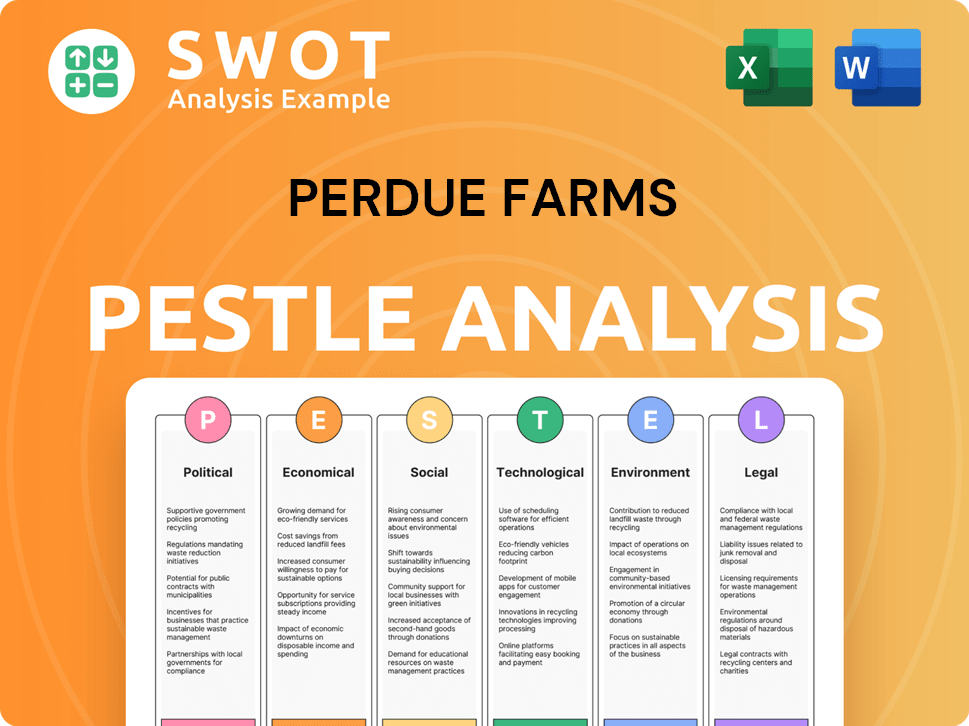
What are the key Milestones in Perdue Farms history?
The Perdue Farms history is marked by significant milestones that have shaped the Perdue company into a leading force in the poultry industry. From its early days to its current standing, the company has consistently adapted and innovated to meet the evolving demands of consumers and the market. These achievements reflect its commitment to quality, sustainability, and consumer health.
| Year | Milestone |
|---|---|
| Late 1960s | Frank Perdue pioneered branding his chicken products, making Perdue Chicken a household name through memorable advertising. |
| 1974 | Introduced the PERDUE® OVEN STUFFER® Roaster, a product from its own proprietary breed. |
| 1983 | Became the first poultry processor to provide nutritional labels on its products. |
| 1985 | Initiated a Quality Improvement Process. |
| 1986 | Implemented a new feed diet that substantially reduced fat in chickens. |
| 2007 | Removed all human antibiotics from its feed and launched the Harvestland brand. |
| 2014 | Removed all antibiotics from its hatchery and began using 'antibiotic-free' labels on several of its brands. |
| October 2024 | Championed new standards for 'pasture-raised' labeling, aligning with updated USDA guidelines. |
| January 2025 | Agreed to pay $4 million in restitution and implement enhanced compliance measures to address child labor violations. |
Perdue Farms has consistently embraced innovation to stay ahead in the competitive chicken production market. One of the most notable innovations was the early adoption of branding, with Frank Perdue becoming the face of the company. Furthermore, the company has continually adapted its products and practices to meet consumer demands for healthier and more sustainable options.
Frank Perdue's memorable advertising campaigns transformed Perdue Chicken into a recognizable brand, setting a new standard in the poultry industry. This strategy helped establish brand loyalty and differentiate Perdue Farms from competitors.
Perdue Farms was a pioneer in providing nutritional labels on its products, responding to growing consumer interest in health and wellness. This move demonstrated a commitment to transparency and informed consumer choices.
The company's shift to antibiotic-free products, including the launch of the Harvestland brand, reflected a proactive approach to consumer preferences. By 2014, Harvestland grew to a $200 million business, showing the success of this innovation.
Perdue Farms has focused on sustainability, including developing a poultry litter pelletizing plant. This initiative converted chicken waste into organic fertilizer, showcasing an innovative approach to waste management.
Aligning with updated USDA guidelines in October 2024, Perdue Farms championed new standards for 'pasture-raised' labeling. This move ensures greater transparency for consumers and supports ethical farming practices.
Throughout its history, Perdue Farms has faced various challenges, including intense competition and scrutiny. The company has navigated these hurdles through strategic initiatives and a commitment to continuous improvement. For insights into Perdue Farms' strategic approach, you can explore the Growth Strategy of Perdue Farms.
Perdue Farms has faced strong competition from industry giants like Tyson Foods, which has driven continuous product development and innovation. This rivalry has pushed Perdue to maintain a competitive edge in the market.
The company has been subject to scrutiny regarding its relationships with contracted farmers. Perdue has worked to address concerns and improve its practices to ensure fair treatment and support for its farming partners.
Environmental policies and sustainability practices have been areas of focus, with the company implementing initiatives like the poultry litter pelletizing plant. These efforts aim to minimize environmental impact and promote sustainable operations.
Perdue Farms has faced past union strikes and, more recently, child labor violations. The company has taken steps to address these issues, including paying restitution and implementing enhanced compliance measures, as seen in the $4 million settlement in January 2025.
Adapting to changing consumer preferences and market demands, such as the growing interest in antibiotic-free products, presents ongoing challenges. Perdue must continually innovate to meet these evolving needs.
Economic fluctuations and rising operational costs, including feed and labor, pose challenges for profitability. Perdue must manage these factors effectively to maintain its financial health and competitive position.
Perdue Farms Business Model Canvas
- Complete 9-Block Business Model Canvas
- Effortlessly Communicate Your Business Strategy
- Investor-Ready BMC Format
- 100% Editable and Customizable
- Clear and Structured Layout
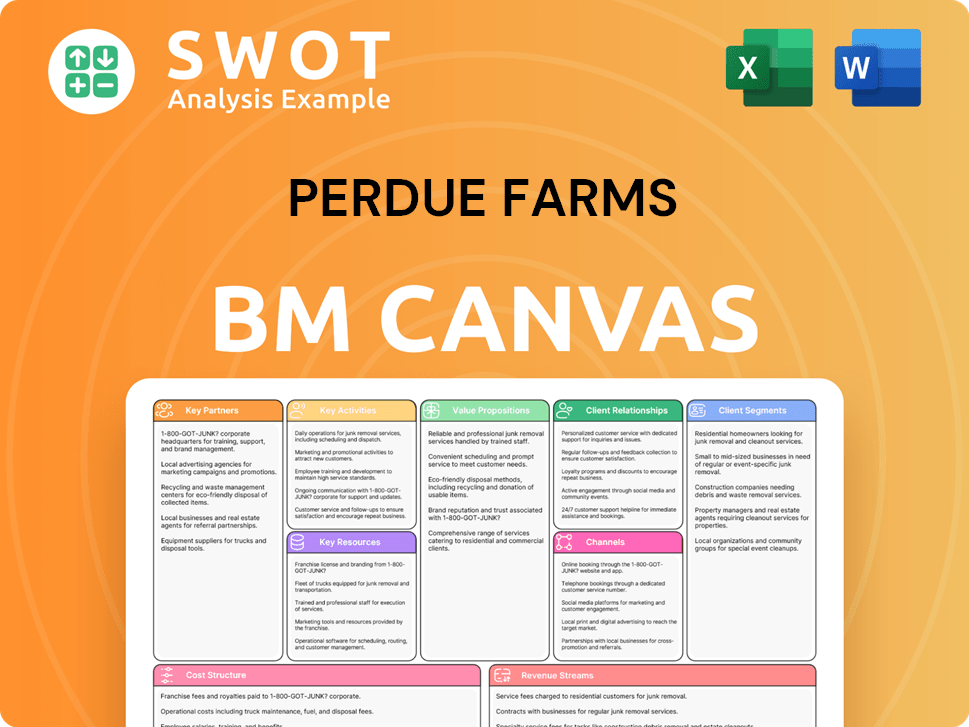
What is the Timeline of Key Events for Perdue Farms?
The history of Perdue Farms, a significant player in the poultry industry, began in 1920 when Arthur W. Perdue established the company as a table-egg business. Over the years, the company evolved, with key figures like Frank Perdue, who played a crucial role in its growth and expansion. The company's journey includes significant milestones such as the introduction of the Perdue brand to retail and the adoption of sustainable practices. Understanding the Target Market of Perdue Farms offers further insights into the company's strategic positioning.
| Year | Key Event |
|---|---|
| 1920 | Arthur W. Perdue founded the company as a table-egg business in Salisbury, Maryland. |
| 1925 | Perdue shifted to selling baby chicks to farmers and built its first hatchery. |
| 1939 | Frank Perdue, Arthur's son, joined the family business. |
| 1950 | Frank Perdue assumed leadership of the company. |
| 1953 | The company was incorporated as A.W. Perdue & Son. |
| 1958 | Perdue built its first feed mill, a key step in vertical integration. |
| 1968 | Perdue opened its first poultry processing plant in Salisbury and introduced the Perdue brand name to retail. |
| 1974 | The PERDUE® OVEN STUFFER® Roaster was introduced. |
| 1977 | Founder Arthur W. Perdue died at 91. |
| 1983 | Perdue became the first poultry processor to provide nutritional labels; Jim Perdue joined the company. |
| 1991 | Jim Perdue was named Chairman. |
| 2001 | Perdue opened its poultry litter pelletizing plant in Delaware. |
| 2007 | Perdue removed all human antibiotics from its feed and launched the Harvestland brand. |
| 2014 | Perdue removed all antibiotics from its hatchery. |
| October 2024 | Perdue Farms champions new USDA guidelines for 'pasture-raised' labeling. |
| November 2024 | Perdue Farms launches 'Miss Madeline,' a new liquid barge for a more sustainable supply chain. |
| January 2025 | Perdue Farms adopts the 'NestBorn' on-farm hatching concept to enhance poultry welfare. |
Perdue Farms is actively transforming its operations through data-driven initiatives. The company is systematically replacing legacy systems to enhance efficiency and explore new product avenues, expanding beyond traditional chicken sales. This commitment to innovation helps them remain competitive within the poultry industry.
The company is dedicated to advancing animal welfare, exemplified by its adoption of on-farm hatching and its advocacy for transparent labeling. Perdue's fiscal year 2024 Company Stewardship Report highlighted progress in corporate sustainability. This included diverting 96.8% of solid waste from landfills and reducing greenhouse gas intensity by 3.6% in FY24.
With annual sales exceeding $10 billion in 2024, Perdue Farms continues to be a major player in the food and agriculture sector. Leadership focuses on generating profitable growth to support strategic plans and ensure future sustainability. The company's financial strength underscores its position in the market.
Perdue Foods aims to be the most trusted name in premium proteins, focusing on creating products for consumers globally while changing how animals are raised for food. This commitment to quality and integrity reflects the founding vision of the company. The legacy of Frank Perdue continues to influence the company's practices.
Perdue Farms Porter's Five Forces Analysis
- Covers All 5 Competitive Forces in Detail
- Structured for Consultants, Students, and Founders
- 100% Editable in Microsoft Word & Excel
- Instant Digital Download – Use Immediately
- Compatible with Mac & PC – Fully Unlocked
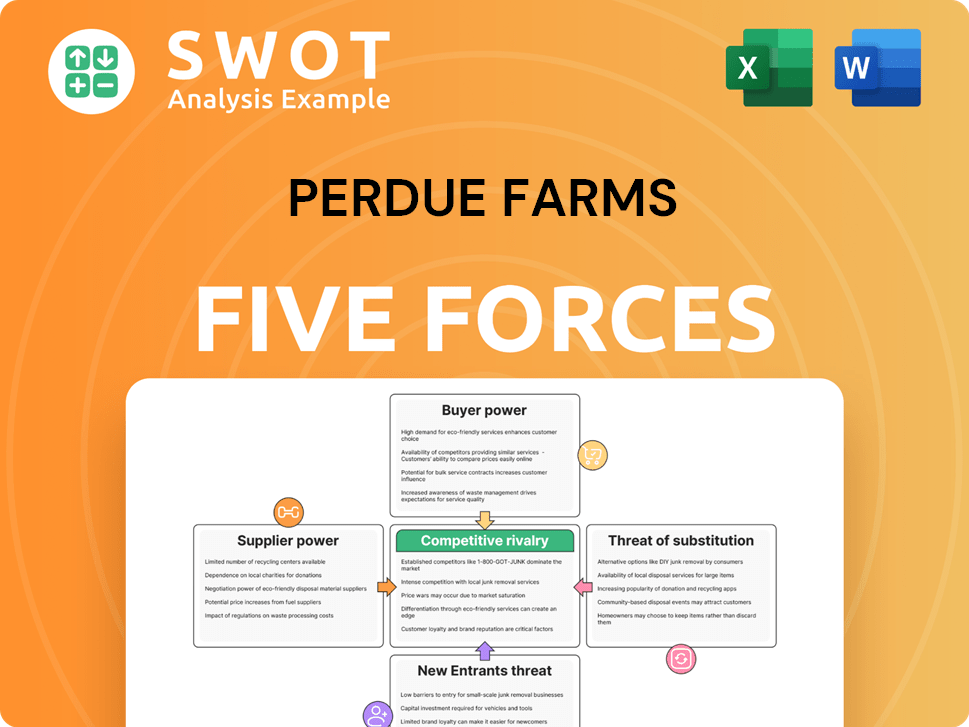
Related Blogs
- What is Competitive Landscape of Perdue Farms Company?
- What is Growth Strategy and Future Prospects of Perdue Farms Company?
- How Does Perdue Farms Company Work?
- What is Sales and Marketing Strategy of Perdue Farms Company?
- What is Brief History of Perdue Farms Company?
- Who Owns Perdue Farms Company?
- What is Customer Demographics and Target Market of Perdue Farms Company?
Disclaimer
All information, articles, and product details provided on this website are for general informational and educational purposes only. We do not claim any ownership over, nor do we intend to infringe upon, any trademarks, copyrights, logos, brand names, or other intellectual property mentioned or depicted on this site. Such intellectual property remains the property of its respective owners, and any references here are made solely for identification or informational purposes, without implying any affiliation, endorsement, or partnership.
We make no representations or warranties, express or implied, regarding the accuracy, completeness, or suitability of any content or products presented. Nothing on this website should be construed as legal, tax, investment, financial, medical, or other professional advice. In addition, no part of this site—including articles or product references—constitutes a solicitation, recommendation, endorsement, advertisement, or offer to buy or sell any securities, franchises, or other financial instruments, particularly in jurisdictions where such activity would be unlawful.
All content is of a general nature and may not address the specific circumstances of any individual or entity. It is not a substitute for professional advice or services. Any actions you take based on the information provided here are strictly at your own risk. You accept full responsibility for any decisions or outcomes arising from your use of this website and agree to release us from any liability in connection with your use of, or reliance upon, the content or products found herein.